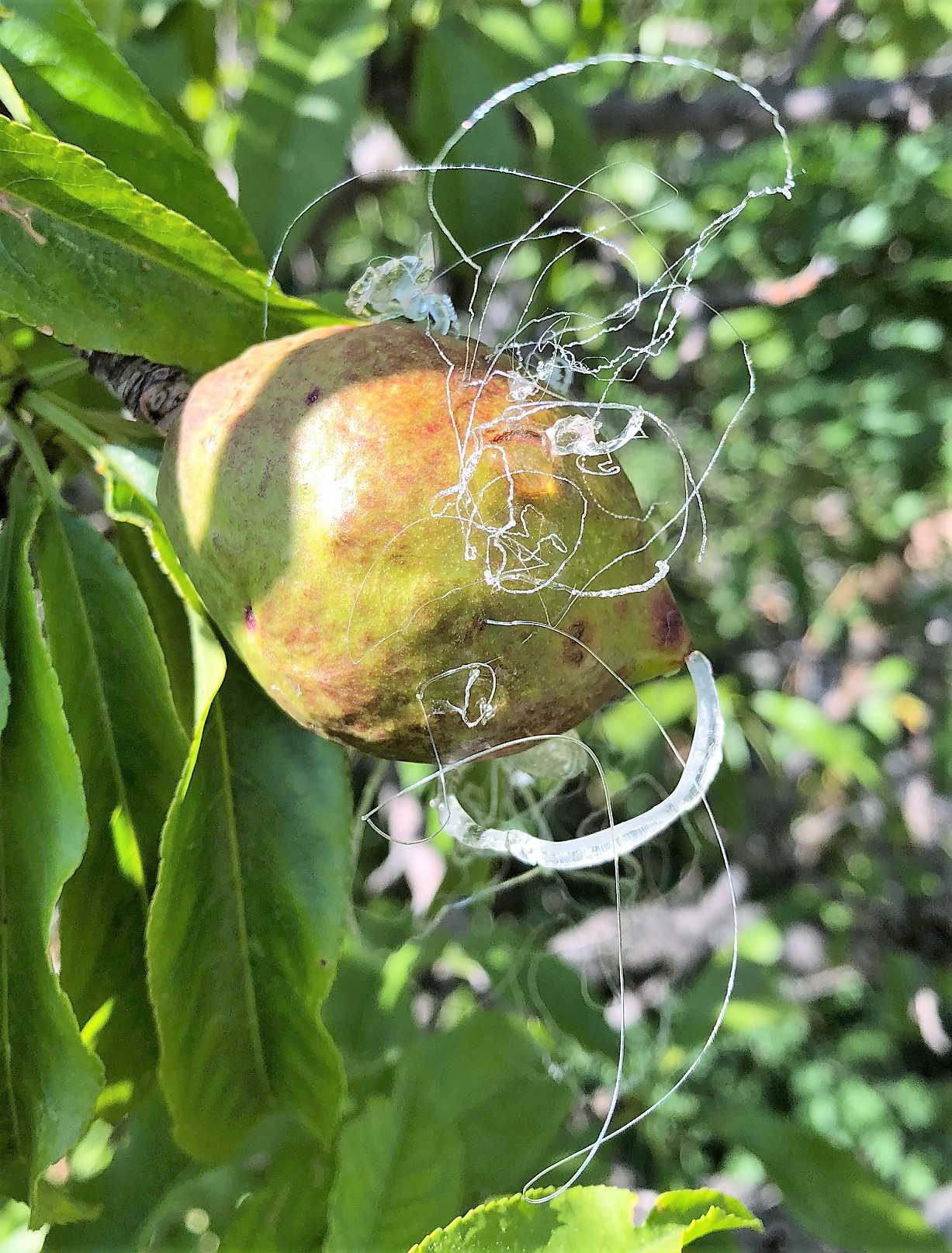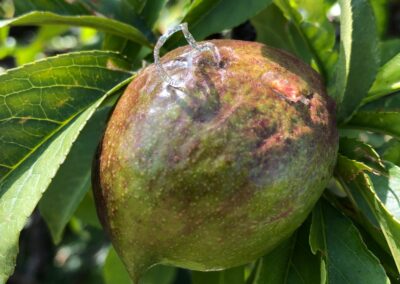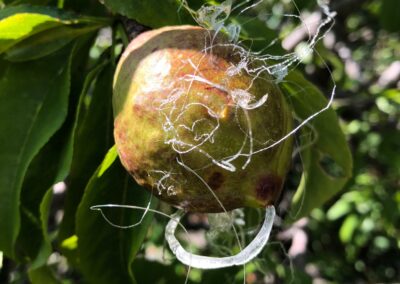Southwest Yard & Garden – Fun with Nectarine Sap Exudate

Nectarine Sap Exudate from Tiny Holes in Peel Created Bizarre Formation: Osmotic Pressure Inside Nectarines Forced Sap to Ooze Delicately
Question: What’s the deal with these clear, stiff, noodle-like formations on my nectarines? Have you ever seen anything like this?
– A. Arber, Albuquerque, NM
-
- Figure 1. Sap exudate oozing out of these nectarines was whipped around by the wind before it had a chance to dry and solidify, making extremely rare decorative formations (photo credits A. Arber).
Answer: Wow, I have never seen anything like this before! I shared your strange photos with several experts from around the state. All agree that the images show extremely rare, spiraling strands of hardened nectarine sap, but there’s no real cause for alarm or recommended action.

Figure 2. Sap exudate along wounded portion of immature nectarine in Albuquerque (photo credit S. Moran
NMSU Bernalillo County Extension Horticulture Agent, Sara Moran, suggested that a species of thrips—or other insects with tiny, rasping,sucking mouthparts—punctured the firm fruit skin, and the internal pressure caused sap to exude. She shared a photo (Fig. 2) of another nectarine in Albuquerque with little short noodles of sap exudate.
Thrips (the correct spelling for both the plural and singular forms) are common, tiny, fringe-winged insects that can be either beneficial when they prey on other pests or harmful when they make mini cat scratch marks on leaves and flowers of various species. They can also be a vector for tomato spotted wilt virus. If you’d like to see live thrips, here’s what you do: walk up to a yucca plant with flowers and shake the flower stalk over a piece of paper or your hand. At first, you might only see other bigger bugs, but look closely and I’ll bet you will see the slender, yellowish thrips running around. They are less than 2 millimeters in length (about 8/100 inch). I did this here at the NMSU Agricultural Science Center in Los Lunas and videoed it (https://nmsudesertblooms.blogspot.com/). Warning: don’t do what I did and get so close to the yucca leaf tips that they poke your finger and make you bleed.
Other possible causes for the nectarine art form were described by Dr. Curtis Smith, my predecessor: “I’m going to guess that we are seeing the combined results of mechanical injury and internal osmotic pressure. Prunus species (i.e., stone fruits, including nectarines, plums, cherries, peaches, and almonds) will especially show jelly-like sap exudation after an injury when the flow of sugary sap meets an obstruction and then finds a hole or crack through which the sap can exude. Hail damage, wind damage, even skin damaged from earlier insect feeding can become rigid and unable to stretch. When water is absorbed, the skin can crack or otherwise form an opening through which the sap can ooze. Wind may be a factor in the fanciful patterns seen in the photographs.”
Hail reports on the Community Collaborative Rain, Hail & Snow Network (CoCoRaHS; https://www.cocorahs.org/ViewData/ListHailReports.aspx) for Bernalillo County highlight two recent hail storms, one on May 21 and one on June 3 of this year.
I Googled intensely for similar images but could not find any resembling this kind of intricate sap pattern. I did learn that “gummosis” is common on tree trunks and can be a sign of a bacterial infection, other disease, or insect wound, and in some plant species is completely normal. California almond growers battle with a pathogenic form that infects the fuzzy fruit called bacterial shot hole.
2021 UPDATE: After writing that column in June 2018, I imagined that the clear, hardened sap might taste like candy. So upon getting back to the client, I asked if he’d try it. He reported back that it had no particular flavor, which actually makes more sense this early in the season before the fruit ripen and get sweet.
I’ve received several photos of hardened gummosis on nectarines and plums in the past month, although none as whimsical as the delicate exudate structures protruding from the nectarines in 2018. Maybe this is the price we pay in years when we don’t lose our fruit crops to late freezes or hail storms.
It’s time to thin fruit on trees that have a heavy load anyways. And purging the gummy ones is a good way to start. I know it’s emotionally hard to do, but getting rid of these uglier fruits allows the sugars they would have gotten to be sent to other fruit. Even under the best circumstances, damaged fruit often have trouble fully ripening. Thinning before other fruit mature helps the survivors get those sugars and other goodies. For more on the importance of fruit thinning, visit Thinning Fruit for Tree Health (Desert Blooms).
For more information on garden insects and diseases, check out these NMSU Cooperative Extension Service publications:
“Pocket Guide to the Beneficial Insects of New Mexico”
For more gardening information, visit the NMSU Extension Horticulture page at Desert Blooms and the NMSU Horticulture Publications page. Find your local Cooperative Extension Office at https://aces.nmsu.edu/county/.
Dr. Marisa Y. Thompson, Ph.D., is the Extension Urban Horticulture Specialist in the Department of Extension Plant Sciences and is based at the New Mexico State University Agricultural Science Center at Los Lunas.


